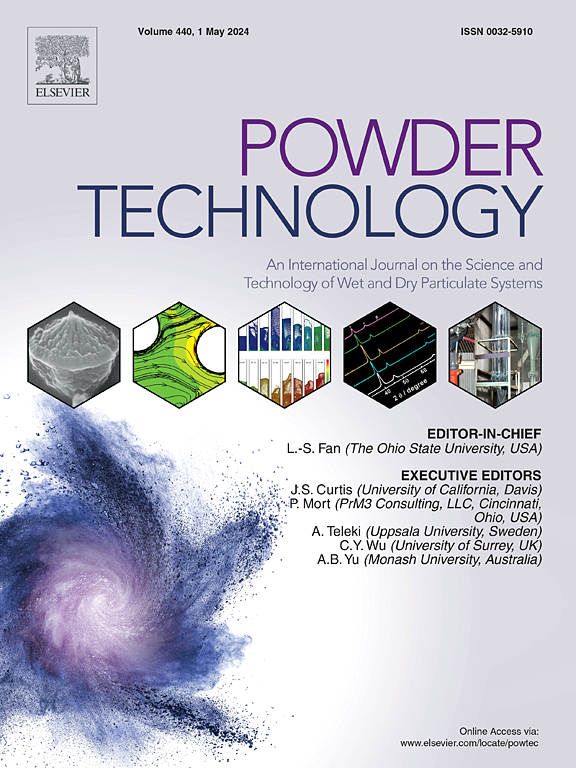Polycarbonate resin powder production via steam precipitation process: Experiment and CFD simulation
IF 4.5
2区 工程技术
Q2 ENGINEERING, CHEMICAL
引用次数: 0
Abstract
Polycarbonate (PC) is a widely used thermoplastic material with excellent transparency and physical toughness. Steam precipitation is a common method for converting PC in dichloromethane (DCM) solution into PC powder. To solve the problem of uneven droplet size and distribution in the steam precipitation atomization process, this paper constructs a simulation model of the atomization process of a steam precipitation jet, combines CFD theoretical analysis and experimental numerical analysis, and investigates the effects of ejector structure and operating conditions on the droplet size and distribution, including the diameter (D) of the feed hole, the steam flow rate, and the feed pressure. The results show that when the steam flow rate is at a high position, the average size of droplets is the smallest, and the number of droplets with a diameter less than 0.07 mm is the largest, accounting for about 57 % of the total number of droplets. Under the liquid flow rate kept constant, the smaller nozzle diameter of the ejector leads to smaller droplet size and wilder distribution. The number of droplets whose diameter is less than 0.07 mm accounts for almost about 50 %,70 %, and 80 % of the total when the nozzle diameter is 3.30 mm, 2.50 mm, and 2.0 mm, respectively. it is recommended to use D = 2.50 mm to improve the atomization dispersion effect, reduce energy consumption, and obtain a larger average particle size and a smaller distribution coefficient, which can avoid the accumulation of PC particles and thermal change caused by the presence of the retention zone and improve the efficiency of the atomization process. This study further optimizes the process conditions of the steam precipitation process, provides an essential reference for the improvement of the ejector, improves the efficiency and product quality of the PC powder production process, and promotes the promotion and development of the technology in the practical application of PC.

通过蒸汽沉淀工艺生产聚碳酸酯树脂粉末:实验和 CFD 模拟
聚碳酸酯(PC)是一种广泛使用的热塑性材料,具有出色的透明度和物理韧性。蒸汽沉淀是将二氯甲烷(DCM)溶液中的聚碳酸酯转化为聚碳酸酯粉末的常用方法。为了解决蒸汽沉淀雾化过程中液滴大小和分布不均匀的问题,本文构建了蒸汽沉淀射流雾化过程的模拟模型,结合 CFD 理论分析和实验数值分析,研究了喷射器结构和操作条件对液滴大小和分布的影响,包括进料孔直径(D)、蒸汽流量和进料压力。结果表明,当蒸汽流速处于较高位置时,液滴的平均尺寸最小,直径小于 0.07 毫米的液滴数量最多,约占液滴总数的 57%。在液体流速保持不变的情况下,喷射器的喷嘴直径越小,液滴尺寸越小,分布越广。喷嘴直径分别为 3.30 毫米、2.50 毫米和 2.0 毫米时,直径小于 0.07 毫米的液滴数量几乎占总数的 50%、70% 和 80%。建议使用 D = 2.50 毫米,以改善雾化分散效果,降低能耗,获得更大的平均粒径和更小的分布系数,从而避免因滞留区的存在而导致的 PC 粒子堆积和热变化,提高雾化过程的效率。该研究进一步优化了蒸汽沉淀工艺的工艺条件,为喷射器的改进提供了重要参考,提高了 PC 粉体生产工艺的效率和产品质量,促进了该技术在 PC 实际应用中的推广和发展。
本文章由计算机程序翻译,如有差异,请以英文原文为准。
求助全文
约1分钟内获得全文
求助全文
来源期刊

Powder Technology
工程技术-工程:化工
CiteScore
9.90
自引率
15.40%
发文量
1047
审稿时长
46 days
期刊介绍:
Powder Technology is an International Journal on the Science and Technology of Wet and Dry Particulate Systems. Powder Technology publishes papers on all aspects of the formation of particles and their characterisation and on the study of systems containing particulate solids. No limitation is imposed on the size of the particles, which may range from nanometre scale, as in pigments or aerosols, to that of mined or quarried materials. The following list of topics is not intended to be comprehensive, but rather to indicate typical subjects which fall within the scope of the journal's interests:
Formation and synthesis of particles by precipitation and other methods.
Modification of particles by agglomeration, coating, comminution and attrition.
Characterisation of the size, shape, surface area, pore structure and strength of particles and agglomerates (including the origins and effects of inter particle forces).
Packing, failure, flow and permeability of assemblies of particles.
Particle-particle interactions and suspension rheology.
Handling and processing operations such as slurry flow, fluidization, pneumatic conveying.
Interactions between particles and their environment, including delivery of particulate products to the body.
Applications of particle technology in production of pharmaceuticals, chemicals, foods, pigments, structural, and functional materials and in environmental and energy related matters.
For materials-oriented contributions we are looking for articles revealing the effect of particle/powder characteristics (size, morphology and composition, in that order) on material performance or functionality and, ideally, comparison to any industrial standard.
 求助内容:
求助内容: 应助结果提醒方式:
应助结果提醒方式:


